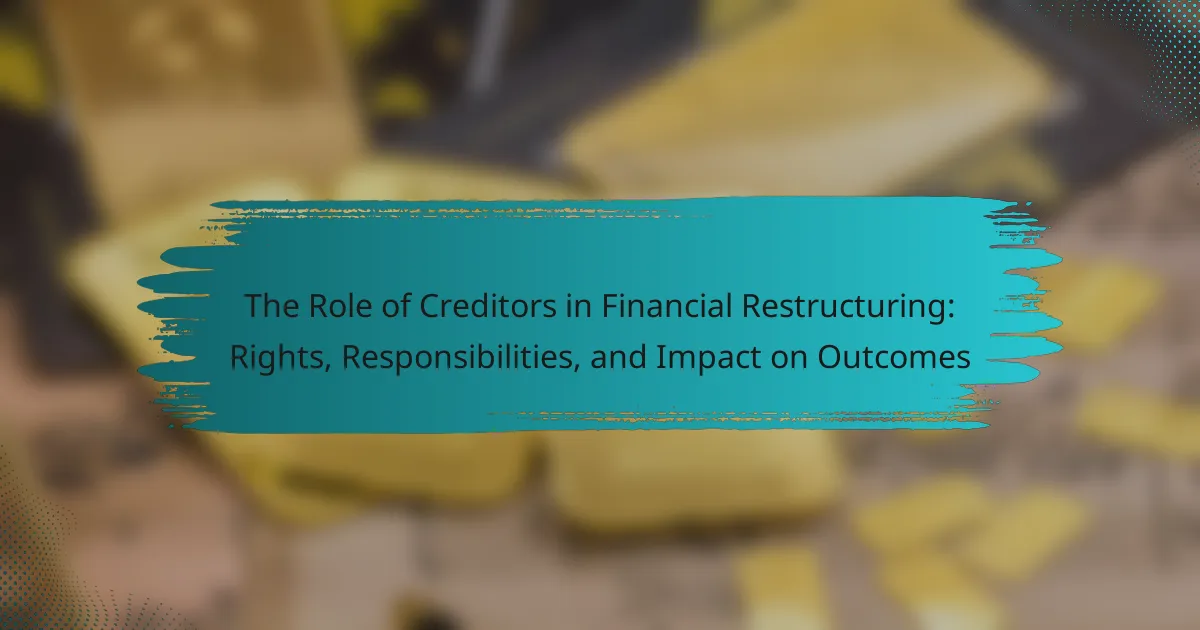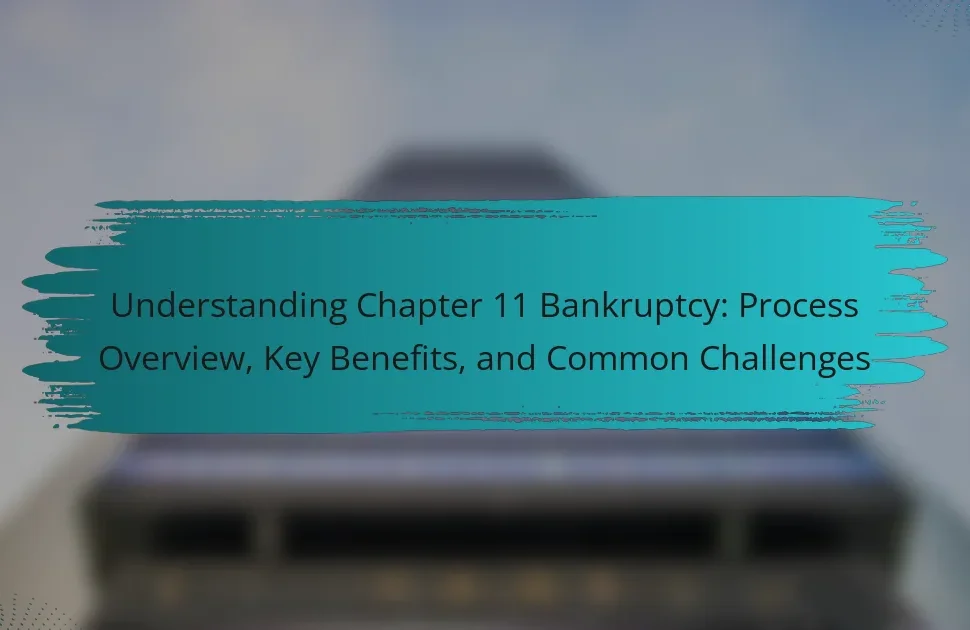Creditors are key participants in financial restructuring, influencing negotiation outcomes and shaping the financial stability of the entity undergoing the process. This article outlines the roles of different types of creditors, including secured, unsecured, and subordinated creditors, detailing their rights, responsibilities, and the impact of their decisions on restructuring outcomes. Effective communication and collaboration among creditors are emphasized as essential for achieving favorable terms and maintaining transparency. The article also highlights the importance of thorough financial assessment, flexibility in negotiations, and proper documentation to protect creditor interests during restructuring.

What is the Role of Creditors in Financial Restructuring?
Creditors play a crucial role in financial restructuring. They provide essential input during the negotiation process. Their consent is often needed for any restructuring plan to be implemented. Creditors assess the viability of the proposed plans. They also influence the terms of debt repayment and potential concessions. Their decisions can significantly affect the outcomes of the restructuring efforts. Effective communication with creditors can lead to more favorable terms. Ultimately, creditors help shape the financial stability of the entity undergoing restructuring.
How do creditors influence the financial restructuring process?
Creditors significantly influence the financial restructuring process by controlling access to capital and negotiating terms. Their approval is often necessary for any restructuring plan to be implemented. Creditors can dictate the restructuring terms, including debt forgiveness and interest rates. They may also push for changes in management or operational strategies. This influence stems from their financial stake in the entity’s success. Research shows that creditor involvement can lead to more favorable outcomes in restructuring efforts. For instance, a study by Altman and Hotchkiss (2006) highlights that creditor cooperation often results in higher recovery rates. Thus, creditors play a pivotal role in shaping the restructuring landscape.
What are the key responsibilities of creditors during restructuring?
Creditors have several key responsibilities during restructuring. They must assess the financial situation of the debtor accurately. This involves reviewing financial statements and understanding the debtor’s cash flow. Creditors should participate in negotiations regarding the terms of the restructuring. They need to communicate effectively with the debtor and other stakeholders. Creditors are also responsible for evaluating proposed plans to ensure they are viable. They must vote on the restructuring plan and provide necessary approvals. Additionally, creditors should monitor compliance with the agreed terms post-restructuring. Engaging in these responsibilities helps protect their interests and supports successful outcomes.
What rights do creditors hold in financial restructuring scenarios?
Creditors hold several rights in financial restructuring scenarios. They have the right to participate in negotiations regarding the restructuring plan. Creditors can vote on proposed plans that affect their interests. They also have the right to receive information about the debtor’s financial status. Creditors may enforce their claims through legal actions if agreements are not honored. Additionally, they can object to plans that do not provide fair treatment. These rights are typically outlined in bankruptcy laws and restructuring agreements. For instance, the U.S. Bankruptcy Code provides specific protections and rights for creditors during Chapter 11 proceedings.
Why is the role of creditors crucial in financial outcomes?
Creditors play a crucial role in financial outcomes because they provide the necessary capital for businesses and individuals to operate. Their willingness to extend credit directly influences liquidity and investment opportunities. When creditors assess risk, they determine lending terms that can affect a borrower’s financial stability. Favorable credit terms can lead to growth, while unfavorable terms can hinder progress. Additionally, creditors often have significant influence during financial restructuring processes. They may negotiate repayment plans or debt forgiveness that can reshape a borrower’s financial landscape. Historical data shows that successful restructuring often hinges on creditor cooperation. For example, in the 2008 financial crisis, creditor involvement was pivotal in stabilizing distressed companies. Thus, the role of creditors is essential in determining financial health and recovery.
How do creditors’ decisions impact the success of restructuring?
Creditors’ decisions significantly impact the success of restructuring. Their willingness to negotiate terms can determine whether a company can achieve a viable plan. For instance, if creditors agree to debt forgiveness, it reduces the financial burden on the entity. Conversely, if they refuse to cooperate, it may lead to bankruptcy. Research shows that creditor support is crucial for operational turnaround. A study by the International Monetary Fund indicates that cooperative creditor behavior correlates with higher success rates in restructuring cases. Thus, creditors play a pivotal role in shaping the outcomes of restructuring efforts.
What are the potential consequences of creditor actions on stakeholders?
Creditor actions can significantly impact stakeholders in various ways. When creditors enforce their rights, it may lead to asset liquidation. This can decrease the value of the company, affecting shareholders negatively. Employees may face job losses due to restructuring efforts initiated by creditors. Suppliers might experience delayed payments or reduced orders, impacting their revenue. Customers could see a decline in service quality or product availability. Additionally, creditors’ decisions can influence the company’s reputation in the market. Research indicates that aggressive creditor actions often exacerbate financial distress, leading to worse outcomes for all parties involved.

What are the different types of creditors involved in financial restructuring?
The different types of creditors involved in financial restructuring include secured creditors, unsecured creditors, and subordinated creditors. Secured creditors hold collateral against the debt they are owed. This means they have a claim on specific assets if the borrower defaults. Unsecured creditors do not have collateral backing their loans. They are at a higher risk during restructuring since they are paid after secured creditors. Subordinated creditors have a lower priority in the repayment hierarchy. They are paid only after senior creditors have been satisfied. Each type of creditor plays a distinct role in the restructuring process. Their rights and claims influence the outcome of the financial restructuring.
How do secured and unsecured creditors differ in their roles?
Secured creditors have collateral backing their loans, while unsecured creditors do not. This distinction affects their roles significantly during financial restructuring. Secured creditors have priority in repayment if the borrower defaults. They can claim specific assets to recover their debts. Unsecured creditors, on the other hand, rely solely on the borrower’s promise to repay. They are often last in line during asset liquidation. This hierarchy influences negotiations in financial restructuring processes. For instance, secured creditors may push for quicker resolutions to protect their interests. In contrast, unsecured creditors may face higher risks and potential losses. The difference in roles shapes the overall dynamics of creditor negotiations and outcomes in financial distress situations.
What unique challenges do unsecured creditors face during restructuring?
Unsecured creditors face several unique challenges during restructuring. They often have lower priority in repayment compared to secured creditors. This means they may receive little to no recovery in a bankruptcy scenario. Unsecured creditors also lack collateral backing their claims, increasing their risk. Additionally, they may have limited influence over the restructuring process. This can lead to unfavorable terms in repayment plans. The uncertainty surrounding the debtor’s financial future adds to their challenges. Unsecured creditors must navigate complex negotiations with the debtor and other creditors. This often requires legal expertise and resources they may not possess.
How does the priority of claims affect secured creditors’ influence?
The priority of claims significantly affects secured creditors’ influence. Secured creditors have a legal right to be paid before unsecured creditors in the event of liquidation. This priority enhances their bargaining power during financial restructuring negotiations. For instance, in a bankruptcy scenario, secured creditors can enforce their claims against specific collateral. This ability often leads to secured creditors having a major say in restructuring plans. Their influence is further amplified by the potential to recover more of their investments compared to unsecured creditors. Historical data shows that secured creditors typically receive a higher percentage of their claims in bankruptcy proceedings. Thus, the priority of claims directly correlates with the level of influence secured creditors exert in financial restructurings.
What are the implications of creditor negotiations in restructuring?
Creditor negotiations in restructuring significantly impact the outcomes for distressed entities. These negotiations can lead to altered debt terms, which may improve liquidity for the entity. Successful negotiations often result in reduced interest rates or extended repayment periods. This can enhance the entity’s ability to operate and stabilize financially. Additionally, creditor negotiations may facilitate a consensual restructuring plan, reducing the need for costly bankruptcy proceedings. The involvement of creditors can also influence the restructuring timeline, as their approval is often necessary for any proposed changes. Ultimately, the effectiveness of these negotiations can determine the success or failure of the restructuring process.
How do negotiation strategies differ among various creditor types?
Negotiation strategies differ significantly among various creditor types. Secured creditors often negotiate from a position of strength due to their collateral. They typically seek full repayment or asset recovery. Unsecured creditors, lacking collateral, may adopt a more collaborative approach. Their focus is often on maximizing recovery through compromise. Institutional creditors, like banks, leverage their expertise and influence in negotiations. They may push for restructuring plans that ensure long-term viability. Trade creditors often prioritize maintaining business relationships. They may accept partial payments to keep supply lines open. Each creditor type’s strategy is influenced by their specific interests and risk exposure. This differentiation is crucial in financial restructuring outcomes.
What role does communication play in creditor negotiations?
Communication is essential in creditor negotiations as it facilitates understanding and agreement between parties. Clear communication helps establish trust and transparency during discussions. It allows creditors to articulate their demands and borrowers to express their financial situations. Effective dialogue can lead to mutually beneficial solutions, such as restructuring payment terms. Studies show that improved communication can enhance negotiation outcomes significantly. For instance, a survey by the International Association of Creditors found that 75% of successful negotiations involved open communication channels. This underscores the importance of communication in reaching favorable agreements.

What are the best practices for creditors during financial restructuring?
Creditors should prioritize clear communication during financial restructuring. This ensures all parties understand the terms and expectations. Establishing a collaborative approach fosters trust and cooperation. Creditors must assess the financial situation thoroughly. This includes reviewing cash flow, liabilities, and assets. Engaging with financial advisors can provide valuable insights. Creditors should also be flexible in negotiations. Flexibility allows for creative solutions that benefit all stakeholders. Documenting all agreements is crucial for legal clarity. This protects the interests of creditors in the restructuring process. Regular updates on progress maintain transparency and accountability. This practice helps to align interests and expectations throughout the restructuring.
How can creditors effectively collaborate with debtors?
Creditors can effectively collaborate with debtors by establishing open communication channels. Regular dialogue helps both parties understand each other’s financial situations. Creditors should listen to debtors’ concerns and needs. This fosters a cooperative environment. Creating flexible repayment plans can accommodate debtors’ cash flow. Tailored solutions can improve the likelihood of repayment. Offering incentives for timely payments encourages compliance. Research shows that collaborative approaches can lead to better financial outcomes. For example, a study by the International Monetary Fund found that cooperation improves recovery rates in debt restructuring.
What strategies can enhance creditor-debtor relationships?
Open communication can enhance creditor-debtor relationships. Regular updates about financial status build trust. Transparency in financial reporting reduces misunderstandings. Establishing clear payment terms helps set expectations. Flexibility in negotiations can foster goodwill. Offering incentives for early payments encourages timely transactions. Providing financial education can empower debtors. Lastly, maintaining a professional demeanor supports a positive atmosphere.
What resources are available for creditors navigating restructuring?
Creditors navigating restructuring can access several key resources. Legal advisors provide guidance on rights and obligations during the process. Financial consultants help assess the viability of restructuring plans. Industry associations offer networking opportunities and best practices. Credit rating agencies provide insights on creditworthiness and market conditions. Government agencies may have programs to support creditors in distressed situations. Online platforms and forums facilitate information sharing among creditors. These resources collectively enhance creditors’ ability to make informed decisions during restructuring.
How can creditors stay informed about changes in financial laws?
Creditors can stay informed about changes in financial laws by subscribing to legal updates from reputable sources. These sources include government websites, legal publications, and financial news outlets. Following industry associations also provides timely updates on legislative changes. Attending seminars and webinars hosted by legal experts offers insights into new regulations. Networking with other creditors and financial professionals can facilitate the exchange of information. Utilizing social media platforms for relevant updates can enhance awareness. Regularly reviewing compliance resources ensures creditors remain informed about their obligations. Active participation in industry forums can also provide valuable insights into evolving financial laws.
What tools can assist creditors in evaluating restructuring proposals?
Creditors can use financial modeling software to evaluate restructuring proposals. This software helps in forecasting cash flows and assessing financial viability. Creditors can also utilize credit risk assessment tools. These tools analyze the likelihood of default and overall creditworthiness. Additionally, scenario analysis tools are valuable for assessing different restructuring outcomes. They allow creditors to visualize potential impacts under various conditions. Financial statement analysis tools help creditors understand the company’s current financial health. These tools provide insights into profitability, liquidity, and solvency. Lastly, legal and compliance checklists ensure that proposals adhere to regulatory requirements. This comprehensive approach aids creditors in making informed decisions.
The main entity of this article is creditors in the context of financial restructuring. The article outlines the critical role creditors play in the restructuring process, including their rights, responsibilities, and influence on financial outcomes. It discusses how creditors assess proposals, negotiate terms, and the implications of their decisions for various stakeholders. Different types of creditors, such as secured and unsecured creditors, are examined, along with the unique challenges they face. The article also highlights best practices for effective creditor-debtor collaboration and resources available for creditors navigating restructuring.




